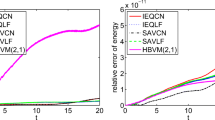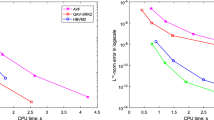Abstract
In this paper, we develop a novel, linearly implicit and local energy-preserving scheme for the sine-Gordon equation. The basic idea is from the invariant energy quadratization approach to construct energy stable schemes for gradient systems, which are energy dispassion. We here take the sine-Gordon equation as an example to show that the invariant energy quadratization approach is also an efficient way to construct linearly implicit and local energy-conserving schemes for energy-conserving systems. Utilizing the invariant energy quadratization approach, the sine-Gordon equation is first reformulated into an equivalent system, which inherits a modified local energy conservation law. The new system are then discretized by the conventional finite difference method and a semi-discretized system is obtained, which can conserve the semi-discretized local energy conservation law. Subsequently, the linearly implicit structure-preserving method is applied for the resulting semi-discrete system to arrive at a fully discretized scheme. We prove that the resulting scheme can exactly preserve the discrete local energy conservation law. Moveover, with the aid of the classical energy method, an unconditional and optimal error estimate for the scheme is established in discrete \(H_h^1\)-norm. Finally, various numerical examples are addressed to confirm our theoretical analysis and demonstrate the advantage of the new scheme over some existing local structure-preserving schemes.














Similar content being viewed by others
References
Ablowitz, M.J., Herbst, B.M., Schober, C.M.: On the numerical solution of the sine-Gordon equation. J. Comput. Phys. 131, 354–367 (1997)
Argyris, J., Haase, M., Heinrich, J.C.: Finite element approximation to two-dimensional sine-Gordon solitons. Comput. Methods Appl. Mech. Eng. 86, 1–26 (1991)
Bratsos, A.G.: The solution of the two-dimensional sine-Gordon equation using the method of lines. J. Comput. Appl. Math. 85, 241–252 (2008)
Brugnano, L., Frasca Caccia, G., Iavernaro, F.: Energy conservation issues in the numerical solution of the semilinear wave equation. Appl. Math. Comput. 270, 842–870 (2015)
Brugnano, L., Iavernaro, F.: Line Integral Methods for Conservative Problems. Chapman et Hall, Boca Raton (2016)
Cai, J., Wang, Y., Liang, H.: Local energy-preserving and momentum-preserving algorithms for coupled nonlinear Schrödinger system. J. Comput. Phys. 239, 30–50 (2013)
Cai, W., Li, H., Wang, Y.: Partitioned averaged vector field methods. J. Comput. Phys. 370, 25–42 (2018)
Celledoni, E., Grimm, V., McLachlan, R.I., McLaren, D.I., O’Neale, D., Owren, B., Quispel, G.R.W.: Preserving energy resp. dissipation in numerical PDEs using the “average vector field” method. J. Comput. Phys. 231, 6770–6789 (2012)
Christiansen, P.L., Lomdahl, P.S.: Numerical solution of 2+1 dimensional sine-Gordon solitons. Physica D 2, 482–494 (1981)
Dahlby, M., Owren, B.: A general framework for deriving integral preserving numerical methods for PDEs. SIAM J. Sci. Comput. 33, 2318–2340 (2011)
Dehghan, M., Ghesmati, A.: Numerical simulation of two-dimensional sine-Gordon solitons via a local weak meshless technique based on the radial point interpolation method (RPIM). Comput. Phys. Commun. 181, 772–786 (2010)
Dehghan, M., Shokri, A.: A numerical method for solution of the two-dimensional sine-Gordon equation using the radial basis functions. Math. Comput. Simul. 79, 700–715 (2008)
Djidjeli, K., Price, W.G., Twizell, E.H.: Numerical solutions of a damped sine-Gordon equation in two space variables. J. Eng. Math. 29, 347–369 (1995)
Furihata, D.: Finite-difference schemes for nonlinear wave equation that inherit energy conservation property. J. Comput. Appl. Math. 134, 37–57 (2001)
Gong, Y., Cai, J., Wang, Y.: Some new structure-preserving algorithms for general multi-symplectic formulations of Hamiltonian PDEs. J. Comput. Phys 279, 80–102 (2014)
Gong, Y., Wang, Y., Wang, Q.: Linear-implicit conservative schemes based on energy quadratization for Hamiltonian PDEs. Preprint
Guo, B., Pascual, P.J., Rodriguez, M.J., Vázquez, L.: Numerical solution of the sine-Gordon equation. Appl. Math. Comput. 18, 1–14 (1986)
Hong, J., Jiang, S., Li, C., Liu, H.: Explicit multi-symplectic methods for Hamiltonian wave equations. Commun. Comput. Phys. 2, 662–683 (2007)
Jiang, C., Sun, J., Li, H., Wang, Y.: A fourth-order AVF method for the numerical integration of sine-Gordon equation. Appl. Math. Comput. 313, 144–158 (2017)
Jiwari, R., Pandit, S., Mittal, R.C.: Numerical simulation of two-dimensional sine-Gordon solitons by differential quadrature method. Comput. Phys. Commun. 183, 600–616 (2012)
Josephson, J.D.: Supercurrents through barries. Adv. Phys. 14, 419–451 (1965)
Kang, X., Feng, W., Cheng, K., Guo, C.: An efficient finite difference scheme for the 2D sine-Gordon equation. arXiv:1706.08632v1 (2017)
Khaliq, A.Q.M., Abukhodair, B., Sheng, Q.: A predictor-corrector scheme for the sine-Gordon equation. Numer. Methods Partial Differ. Equ. 16, 133–146 (2000)
Li, H., Sun, J., Qin, M.: New explicit multi-symplectic scheme for nonlinear wave equation. Appl. Math. Mech. Engl. Ed. 35, 369–380 (2014)
Li, S., Vu-Quoc, L.: Finite difference calculus invariant structure of a class of algorithms for the nonlinear Klein–Gordon equation. SIAM. J. Numer. Anal. 32, 1839–1875 (1995)
Li, Y., Wu, X.: General local energy-preserving integrators for solving multi-symplectic Hamiltonian PDEs. J. Comput. Phys. 301, 141–166 (2015)
Liu, C., Wu, X.: Arbitrarily high-order time-stepping schemes based on the operator spectrum theory for high-dimensional nonlinear Klein–Gordon equations. J. Comput. Phys. 340, 243–275 (2017)
Matsuo, T., Furihata, D.: Dissipative or conservative finite-difference schemes for complex-valued nonlinear partial differential equations. J. Comput. Phys. 171, 425–447 (2001)
McLachlan, R.: Symplectic integration of Hamiltonian wave equations. Numer. Math. 66, 465–492 (1994)
Reich, S.: Multi-symplectic Runge–Kutta collocation methods for Hamiltonian wave equations. J. Comput. Phys. 157, 473–499 (2000)
Schober, C.M., Wlodarczyk, T.H.: Dispersive properties of multisymplectic integrators. J. Comput. Phys. 227, 5090–5104 (2008)
Shen, J., Xu, J., Yang, J.: A new class of efficient and robust energy stable schemes for gradient flows. arXiv:1710.01331 (2017)
Shen, J., Xu, J., Yang, J.: The scalar auxiliary variable (SAV) approach for gradient. J. Comput. Phys. 353, 407–416 (2018)
Sheng, Q., Khaliq, A.Q.M., Voss, D.A.: Numerical simulation of two-dimensional sine-Gordon solitons via a split cosine scheme. Math. Comput. Simul. 68, 355–373 (2005)
Wang, Y., Wang, B., Ji, Z., Qin, M.: High order symplectic schemes for the sine-Gordon equation. J. Phys. Soc. Jpn. 72, 2731–2736 (2003)
Wang, Y., Wang, B., Qin, M.: Local structure-preserving algorithms for partial differential equations. Sci. China Ser. A 51, 2115–2136 (2008)
Yang, X., Zhao, J., Wang, Q.: Numerical approximations for the molecular beam epitaxial growth model based on the invariant energy quadratization method. J. Comput. Phys. 333, 104–127 (2017)
Yang, X., Zhao, J., Wang, Q., Shen, J.: Numerical approximations for a three components Cahn–Hilliard phase-field model based on the invariant energy quadratization method. Math. Models Methods Appl. Sci. 27, 1993–2030 (2017)
Zhang, F., Pérez-García, V.M., Vázquez, L.: Numerical simulation of nonlinear schrödinger systems: a new conservative scheme. Appl. Math. Comput. 71, 165–177 (1995)
Zhang, F., Vázquez, L.: Two energy conserving numerical schemes for the sine-Gordon equation. Appl. Math. Comput. 45, 17–30 (1991)
Zhao, J., Yang, X., Gong, Y., Wang, Q.: A novel linear second order unconditionally energy stable scheme for a hydrodynamic-tensor model of liquid crystals. Comput. Methods Appl. Mech. Engrg. 318, 803–825 (2017)
Zhou, Y.: Applications of Discrete Functional Analysis to the Finite Difference Method. International Academic Publishers, Beijing (1990)
Zhu, H., Tang, L., Song, S., Tang, Y., Wang, D.: Symplectic wavelet collocation method for Hamiltonian wave equations. J. Comput. Phys. 229, 2550–2572 (2010)
Acknowledgements
The authors would like to express sincere gratitude to the referees for their insightful comments and suggestions. This work is supported by the National Natural Science Foundation of China (Grant Nos. 11771213, 61872422, 11871418), the National Key Research and Development Project of China (Grant Nos. 2016YFC0600310, 2018YFC0603500, 2018YFC1504205), the Major Projects of Natural Sciences of University in Jiangsu Province of China (Grant Nos. 15KJA110002, 18KJA110003), the Natural Science Foundation of Jiangsu Province, China (Grant No. BK20171480), the Foundation of Jiangsu Key Laboratory for Numerical Simulation of Large Scale Complex Systems (201905) and the Yunnan Provincial Department of Education Science Research Fund Project (2019J0956).
Author information
Authors and Affiliations
Corresponding author
Additional information
Publisher's Note
Springer Nature remains neutral with regard to jurisdictional claims in published maps and institutional affiliations.
Rights and permissions
About this article
Cite this article
Jiang, C., Cai, W. & Wang, Y. A Linearly Implicit and Local Energy-Preserving Scheme for the Sine-Gordon Equation Based on the Invariant Energy Quadratization Approach. J Sci Comput 80, 1629–1655 (2019). https://doi.org/10.1007/s10915-019-01001-5
Received:
Revised:
Accepted:
Published:
Issue Date:
DOI: https://doi.org/10.1007/s10915-019-01001-5




